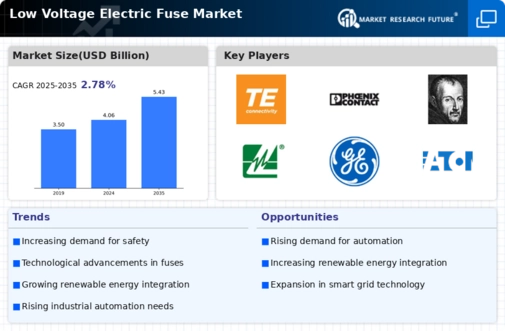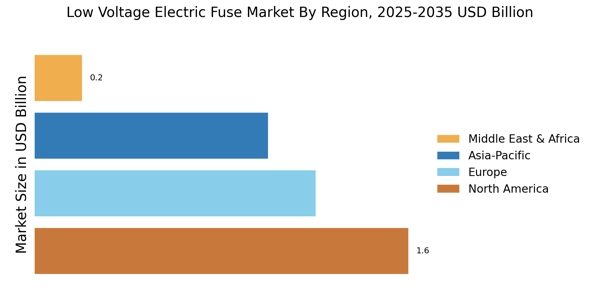Increased Focus on Safety Standards
The heightened focus on safety standards and regulations is significantly influencing the Low Voltage Electric Fuse Market. Governments and regulatory bodies are implementing stricter safety codes to mitigate electrical hazards, which in turn drives the demand for reliable protective devices like low voltage fuses. These fuses are essential in meeting compliance requirements and ensuring the safety of electrical installations. Recent statistics suggest that the market for safety devices in electrical systems is expected to grow by approximately 6% annually. This trend indicates a robust demand for low voltage electric fuses, as they are integral to adhering to safety regulations and protecting both people and property.
Growth of the Electric Vehicle Market
The rapid growth of the electric vehicle (EV) market is emerging as a significant driver for the Low Voltage Electric Fuse Market. As the adoption of electric vehicles accelerates, the demand for efficient electrical systems within these vehicles increases. Low voltage fuses are crucial for protecting the electrical components of EVs, ensuring their safe operation. Recent projections indicate that the electric vehicle market could expand at a compound annual growth rate of over 20% in the next decade. This surge in EV production and usage is likely to create substantial opportunities for low voltage electric fuses, as they are essential for maintaining the safety and reliability of electric vehicles.
Expansion of Electrical Infrastructure
The ongoing expansion of electrical infrastructure in various regions is a critical driver for the Low Voltage Electric Fuse Market. As urbanization accelerates, the demand for electricity increases, leading to the development of new residential, commercial, and industrial projects. This expansion requires robust electrical systems equipped with low voltage fuses to ensure safety and reliability. Market data indicates that investments in electrical infrastructure are expected to reach trillions of dollars over the next decade. Consequently, the need for low voltage electric fuses will likely rise, as they play a vital role in protecting electrical circuits from faults and ensuring uninterrupted power supply.
Rising Demand for Renewable Energy Sources
The increasing emphasis on renewable energy sources, such as solar and wind, is driving the Low Voltage Electric Fuse Market. As more installations of solar panels and wind turbines occur, the need for reliable protection devices like low voltage fuses becomes paramount. These fuses ensure the safety and efficiency of electrical systems, preventing overloads and short circuits. According to recent data, the renewable energy sector is projected to grow at a compound annual growth rate of over 8% in the coming years. This growth necessitates the integration of low voltage electric fuses to safeguard new energy infrastructures, thereby enhancing the overall market for these essential components.
Technological Innovations in Fuse Manufacturing
Technological innovations in fuse manufacturing are reshaping the Low Voltage Electric Fuse Market. Advances in materials and design are leading to the development of more efficient and reliable fuses. For instance, the introduction of smart fuses that can monitor electrical loads and provide real-time data is gaining traction. This innovation not only enhances safety but also improves the overall performance of electrical systems. Market analysis reveals that the adoption of advanced fuse technologies is likely to increase by 10% over the next few years. Such innovations are expected to drive the demand for low voltage electric fuses, as they offer enhanced functionality and reliability.


















Leave a Comment